| |
Friday, August 31, 2007, 5:10 AM General, BoozePosted by stefanie On a couple of occasions during Undoukai, neighbors told us that a party would take place immediately afterwards. Indeed, while the event judges tallied up the points, each team set up picnic spaces on the outer edges of the field. We had lots of sushi, sashimi, pickles, dango (rice dumplings covered with black sesame, sweetened soy sauce, adzuki bean paste, or edamame paste), onigiri, and packages of cookies and otsumami (beer snacks). 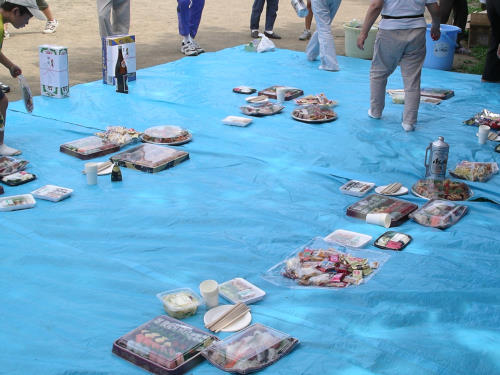 Good thing for all that otsumami, because we had plenty of beer. Including beer in cans so big, they required handles. 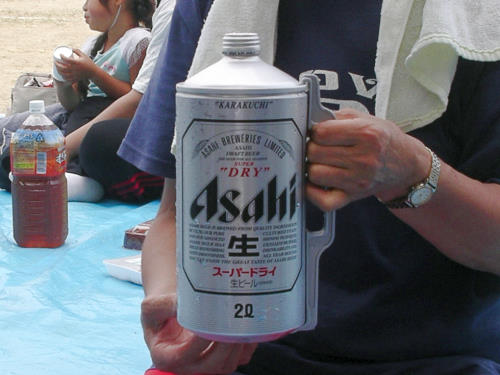 After some time, team captains started circulating, carrying their bottles of sake to share. Matthew was the lucky recipient of many refills and friendly visits. I think everyone was impressed that he could speak some Japanese. Or by his moustache. 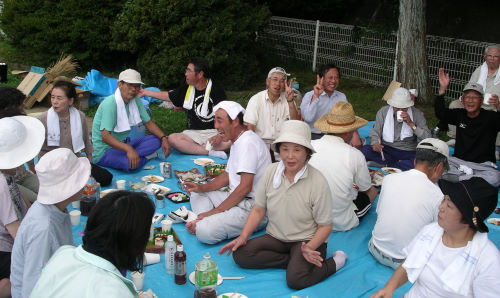 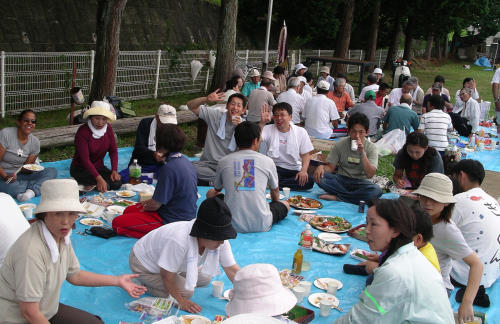 We ate, drank, chatted, and laughed with our neighbors well into the afternoon. When the party broke up, everyone pitched in to clean up. Clean-up involved separating refuse into burnable trash, non-burnable trash, and the various types of recyclables (plastics, paper, etc). *sigh* I love Japanese organization. We walked our bikes home along with our neighbors from across the street. No riding for us — in Japan, it's illegal to ride your bike after drinking.
Fight Fiercely, Kunenbashi
Tuesday, August 28, 2007, 11:07 PM GeneralPosted by stefanie When Matthew and I decided to move to Japan, we were motivated by the desire to learn more about another culture and another way of life. So, when our neighbors invited us to participate in Undoukai, we had to go for it. Gathered by teams for opening speeches and organized calisthenics (not only is there a song, but also a whole ordered routine — probably a lot like the factory workers' morning ritual), we prepared for a day of friendly competition. Our team was announced as third largest, earning us a certain number of points up front. Kunenbashi (the neighborhood, not the bridge), represent! Each team donned a different-colored headband. Team Kunenbashi wore red. The first event was a series of races for the young kids. We adults began our competition with a basketball-passing relay game. A third-place finish in this event stoked our drive for further excellence. Team Kunenbashi performed well throughout the next few events. These included a relay where we dressed a teammate as a scarecrow, then walked him to the finish line; tea can/beer bottle/giant sake bottle ring toss; and filling a giant sake bottle with team-colored liquid by using small tea cups. And then, we met our Waterloo: Janken. Janken is a game of extreme skill and concentration, perhaps a bit too much so for the good-natured competition of undoukai. Oh, who am I kidding — it's Rock, Paper, Scissors, and we blew. Team Kunenbashi scored ONE POINT, thanks to our very last player. I think we may want to consider some janken drills in advance of next year's event. The next event was a 1500m road race. Up to this point, Matthew and I had been responding eagerly to each call for our participation, even if we didn't comprehend totally what the event was. In this case, we thought it was an 800m run. Because neither one of us is particularly athletic, I think we got in a little deep. Matthew ran admirably, finishing in the middle of the pack. Here he is after the race, wearing the cool, damp towel worn by all the other men after a particularly strenuous event. 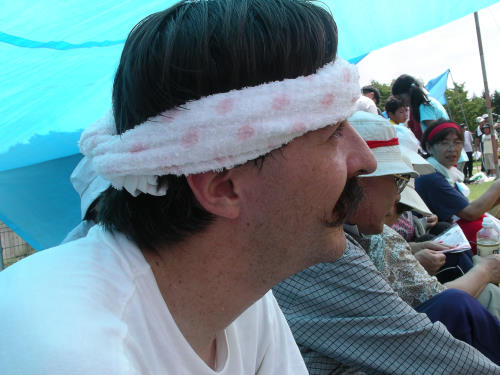 Well, not the same towel. You know what I mean. Team Kunenbashi won the next event, tossing small balls into baskets held high overhead. We were not so successful in the tug-of-war, losing both of our elimination bouts. We regained momentum with a third-place finish in the rope-making event. Wow. Before Sunday, I couldn't imagine this at a sports day: "Okay, now we're going to make some rope."  The people participating in the rope-making event were amazing, cranking out more than four meters (about thirteen feet) of rope in five minutes. The athletics resumed with three final races: a stick-and-hoop relay, a women's relay, and a men's relay, with each leg of the latter two being run by a person fitting into a certain age range (a "different generations" relay, if you will). The stick-and-hoop relay was rather impressive, with Team Kunenbashi demonstrating enough skill to achieve a second-place finish. 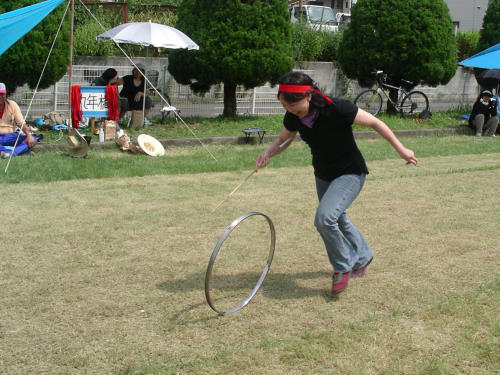 Team Kunenbashi lacked someone to run the fortysomething leg of the women's relay, so between the two thirtysomethings, they picked me to be "fortysomething." We also had to borrow an elementary school student from another neighborhood. Sadly, Team Kunenbashi did not place in either of the last two races. Overall, we finished in fourth place out of five teams. Nevertheless, we had a great time, which was the point. And we still got our cases of beer and bottles of sake as participant rewards. 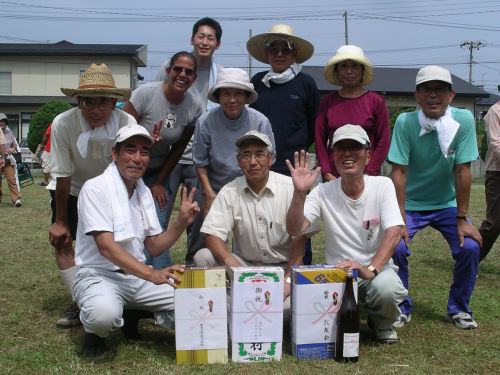 Confidential to Saru-chan: Happy Birthday!
Sunday, August 26, 2007, 8:17 PM General, BoozePosted by matthew It's a little after 4:00 pm, and we're drunk. This can only mean one thing: undoukai! Undou(exercise)kai(meet) is an annual "sports day" when neighborhoods compete with each other in "sports" such as Rock-Paper-Scissors and the 1500 meter "marathon". For the over-fifty crowd there was even a rope-making contest, which was quite a sight to see. (Our neighborhood, Kunenbashi, came in third out of five with about 4 meters of rope in about 5 minutes.)
All that's in the morning, though. The real reason everybody goes is for the after-party/picnic. Sushi, sashimi, fried foods, crackers, dessert, and all the beer or sake you can drink ¡½ actually, more than you can drink, because everyone will want to refill your glass and drink with you, at least if you're a foreigner.
It was fun, but now we're tired and drunk, so we'll write more and post some photos later. Ja, mata ne! Gokurou-sama deshita!
[ add comment ] permalink
Friday, August 24, 2007, 3:05 AM GeneralPosted by matthew 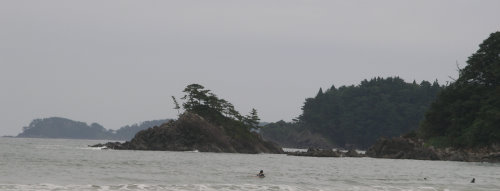 On Saturday, we met up with some friends to caravan down to the Pacific coast in Miyagi Prefecture, heading for the beach where all the Kitakami surfers go to catch waves. The mountains march right out to sea here, separating the beaches with rocky ledges and shelves. We're windsurfers, but we'd never done real surfing before, so some lessons were in order. We lacked skills but not confidence as we strode out into the water with our instructor and his assistant. 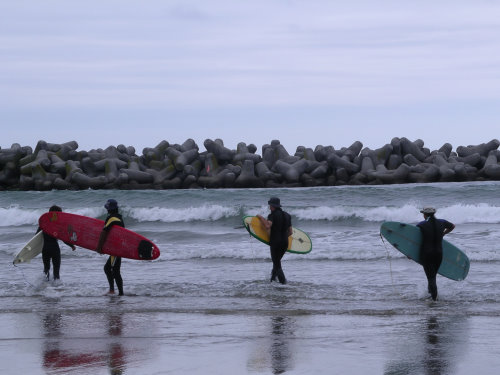 After they wore us out with paddling, they decided to give us a taste of what it's like to catch a wave. Standing up was still impossible for us, but you don't need to stand up to go fast! 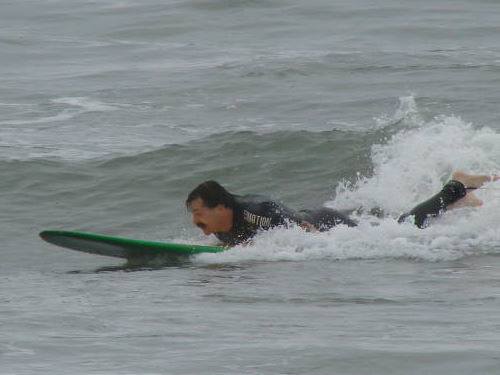 Is it fun? Maybe you can see the big grin on Stefanie's face after a good ride. 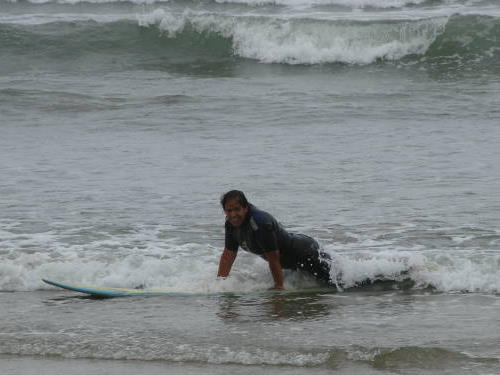 After a couple of hours we were tired, hungry, and sore. Some yakisoba and onigiri took care of the hunger, but we were still tired and sore for the trip home. At some points, the road provided an overview of the rows upon rows of mountains looming between us and a much-needed rest. 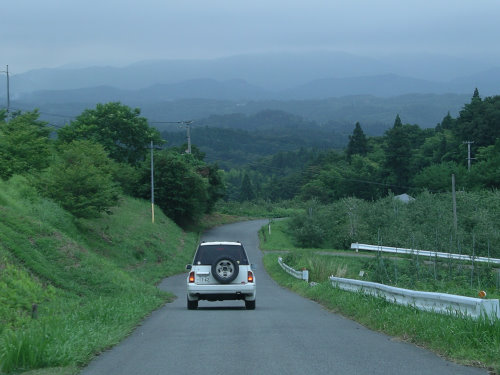 Regardless, Stefanie persevered and got us home safely.
Conquering Your Fears (Well, Mine Anyway)
Thursday, August 23, 2007, 12:27 AM GeneralPosted by stefanie Between the Great Tokyo Junket of '07 and last week's series of road trips, it seems our journeys have settled into a predictable rhythm. We hit the road, full of excitement about The Road Ahead. At some point, Matthew will comment (more or less urgently, depending on the situation) that I am way too close to the line/post/ditch/guardrail on the left for his liking. (Didn't Beyonce just have a song out about this? "To the left, to the left/Try to keep the car out the ditch to the left.") I will remind him that he can, at any time, study for and take the test to get his J-driver's license. The trip will continue smoothly until we come to an inevitable feature of The Road Ahead: an especially narrow stretch of road, usually bordered by a straight-sided ditch just about the exact width of a car tire. Then I momentarily freak out, convinced that I'll either plow into an oncoming car or drive us into the ditch. We eventually reach our destination safely, and I think "Hey, that was kind of cool. Don't be such a ninny." and feel pretty hardcore for being able to drive on Japanese roads. And then I remember that we have to get home.
Let's talk about Japanese roads, shall we? Japan is a country built on islands mostly, if not entirely, formed by volcanoes, resulting in high, pointy mountains with sheer, steep drops. It's an amazingly beautiful country, to be sure, but its geography and land usage necessitate things like high bridges, 800-meter-long tunnels, and narrow mountain roads with hairpin turns and the occasional 8% grade. And when the roads a) are a normal width; b) lack a tire-wide ditch off to the left; and c) have at least a six-inch shoulder, they're wicked fun to drive and make me wish we had the Swedewagon. When they're bordered by ditches and only about two cars wide, however, they're kind of nerve-wracking to drive.
If you read Matthew's previous post, you've read about the bear road. There were neither bears nor other traffic on it, so it was a piece of cake to navigate. Our caravan to Miyagi-ken, however, took us up steep, narrow roads running between rice paddies requiring you to negotiate with the oncoming driver who was crossing first, then back down steep, narrow roads requiring you to negotiate back-to-back-to-back hairpin curves. Coming back was even better because paddling practice during our surf lesson had rendered my shoulders nearly immobile. (Incidentally, we will blog about our surf lesson, because surfing is awesome. Even if you haven't gotten to the point of standing up.)
Prior to last week, a trip to the beach for us meant the Beltway to Route 50 and over the Bay Bridge. In Northern Japan, the mountains end at the beach, so it's twisty roads and rice paddies all the way. Faced with the choice of not driving versus not surfing -- well, there's not really a choice, is there? Ganbarimasu!
[ 3 comments ] permalink
I traveled to Morioka on Thursday to get permission to work on my current visa, which I couldn't otherwise do (it's the dreaded "dependent visa"). I *heart* the Morioka immigration office -- the staff was cordial, informative, and had me out the door with my permit in about 20 minutes, if that. So I took the rest of the afternoon to poke around a bit, beginning with lunch at the 'Bucks. Hey, I had to investigate the possibility of cupcakes (denied!). If the one especially posh street I traversed is representative of the city, Morioka is all about food, art, spas/salons, and fashion. I am a fan. Had I worn a hat, I might have tossed it in the air, I liked Morioka so much. As it was, I refrained from tossing the Weitzmans in the air for fear that their 3" heels would've taken someone's eye out had I failed to catch them. 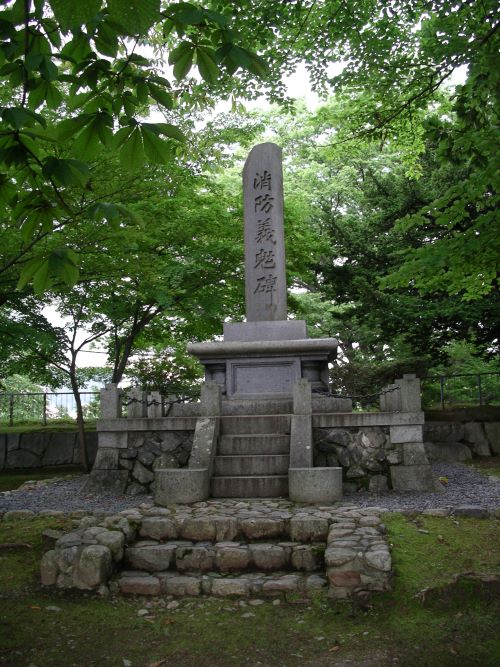 This monument is located in Iwate Park, in the middle of Morioka. Iwate Park is built on the ruins of the former Morioka Castle; its height allows for beautiful views of the city against its mountain backdrop.
[ 5 comments ] permalink
The S & M International Matsuri-Fiesta-Party-Thing
Wednesday, August 8, 2007, 12:54 AM General, FoodPosted by stefanie In the spirit of festivity surrounding matsuri, we invited a couple of friends over for dinner prior to last night's fireworks viewing. I was having some menu-development issues until Sunday, when our neighbor from across the street came over and passed me some garden-fresh tomatoes through the kitchen window. In possession of this bounty, I did what any right-thinking half-Mexican girl would do. I made salsa. And built a menu around it. Menu of chips and salsa, carnitas tacos with avocado (Sidebar: The Japanese word for "avocado" is abogado. I find this tremendously amusing.) and rice decided, we braced ourselves for the reality of our chip-and-tortilla situation. Chips and tortillas are available here, provided you're willing to accept chips and tortillas manufactured in Belgium as a viable option. Which we were, and were pleasantly surprised to discover that they didn't suck. What we were not willing to do was pay 1150 yen, or approximately $10 USD, for a six-pack of Corona. As it turned out, beer was not an issue. One of our friends brought "appropriate food and drink," as she described them when she accepted the invitation. These included edamame, Japanese vegetable chips, grilled corn, and giant cans of Kirin Ichiban beer. Back at the house post-fireworks, another friend introduced us to a snack of cream cheese cubes dipped in wasabi-enriched soy sauce, which was really quite good. Mexican food and Japanese food: two great tastes that go great together!
Friday, August 3, 2007, 10:20 PM GeneralPosted by stefanie Westerners traveling to Japan, especially the more rural areas, usually hear about the "Gaijin Stare" before they arrive. The Gaijin Stare occurs when a native Japanese, well, stares at you because of your foreignness. This phenomenon is likely not unique to Japan.
At just over two months in residence, I've grown accustomed to curious looks or questions about where I'm from. Many times, my Amerika-jin-ness doesn't come up at all. Matthew gets more attention than I do because of his height and The Moustache. The Moustache attracts wonder, awe, and on unfortunate occasions, laughter. A couple of weeks ago, it got laughed at by two separate groups in the same afternoon. The Moustache felt sad, turning its pointy tips down (or maybe that was the effing heat and humidity). Matthew confessed that this had happened previously and that it gets old.
Today, I got the full Gaijin Stare treatment, and it was kind of unnerving. I was putting my bags into the car after leaving the grocery, when I looked up to see the woman in the car across from mine staring at me. And I mean STARING. Open the car door -- staring. Close the door and move to the driver's door -- staring. Get in the car -- staring. Buckle seat belt -- staring. I did look up from what I was doing at one point to see her looking off in a different direction, but when I looked up to leave the parking lot -- staring. Even when I looked directly at her, she kept staring unblinkingly.
I don't know why today was different. Maybe others have stared and I just haven't noticed. I had my hair up, so it's not like I was rocking the curls, which might be stareworthy (Sidebar: Living in Kitakami has been FANTASTIC for my hair -- it's all bouncy and curly! Now I just need to hope for a decent stylist when the time comes.). Maybe it was because, in heels, I was standing about 5'9", or considerably taller than your average Japanese woman. Or maybe she actually was staring at my handbag, making it the Accessory Stare, known to women worldwide.
[ 1 comment ] permalink
Saturday, July 28, 2007, 8:53 PM GeneralPosted by stefanie This is one of the questions Matthew and I, and probably every other gaijin here, frequently get asked. In our experience, it is never followed by "la dee dah, dee dee dah."
There are enough English schools in Kitakami that foreign teachers come and go with some regularity, so we're not unusual in that respect. But, most people are a little surprised to learn that we knew about and loved Tohoku before we moved here. They generally are pleased to learn that Matthew chose his job in part because the company's schools are located primarily in Tohoku. Tohoku is not "where it's happening" in Japan; I've seen it, and specifically Iwate Prefecture, described in various places on the internet as "backwater." We can relate to this as native New Mexicans. When you live near Washington, at most you'll get questions about whether you're in politics, but when you talk about living in New Mexico, reactions range from: "You're so lucky -- that's God's country" to "But there's nothing/nothing to do there!"
When people learn that we came here from Washington, we start getting the latter. "What do you think about Kitakami? Don't you think it's boring?" And the truth is, not really. The area is beautiful, there's a lot of ground to be covered, and we're the new kids in town -- it's all still interesting to us. I don't really understand why people here don't dine alfresco, but that's hardly a dealbreaker.
Conversation naturally turns from Matthew's employment as the reason for our move to my profession. The first time I told someone I was an American lawyer was a revelation:
Person: What do you do? Are you also a teacher?
SKD: I'm a lawyer in America, but I will probably be teaching here.
Person: Sugoi! (translation: Fantastic!)
This reaction is pretty common and rather delightful. The Japanese don't hate lawyers. The relative lack of litigiousness in their society is surely one factor; another is that lawyers are comparatively rare here. None of the Japanese I've encountered has mentioned even knowing a Japanese lawyer. I don't think the Japanese even have lawyer jokes. Which, now that I think about it, is a nice side benefit of being here.
[ 2 comments ] permalink
Tuesday, July 24, 2007, 9:02 PM GeneralPosted by stefanie It's official: Every Davis is a resident of Kitakami-shi, Iwate-ken, Japan. Yesterday, we took Moki and Aki's importation paperwork to the city office and registered them with the city. They're now rocking their Japanese dog tags, written in kanji, and feeling very pleased with themselves. Actually, they're sleeping because it's really honking hot in the house, which is what happens in the summer when you don't have central A/C. Speaking of hot, it was hot enough yesterday (and probably today) that the city employees were dressed in their "Cool Biz" work clothes. The Japanese government began promoting "Cool Biz" in the summer of 2005 as a way to lower energy consumption through reduced use of air conditioning. Basically, when the temperature gets above 28 degrees Celsius (82 degrees Fahrenheit), some offices encourage male workers who usually wear suits and ties to wear short-sleeved dress shirts with open collars. Everyone is encouraged to wear breathable, moisture-wicking fabric. Essentially, Japan is advocating environmental responsibility through government-sanctioned short-sleeving. Merchant gift update: Since our last report, we've received another box of tissues and a box of laundry detergent from the cell phone company.
[ 1 comment ] permalink
Back Next
|
|


















 Calendar
Calendar




